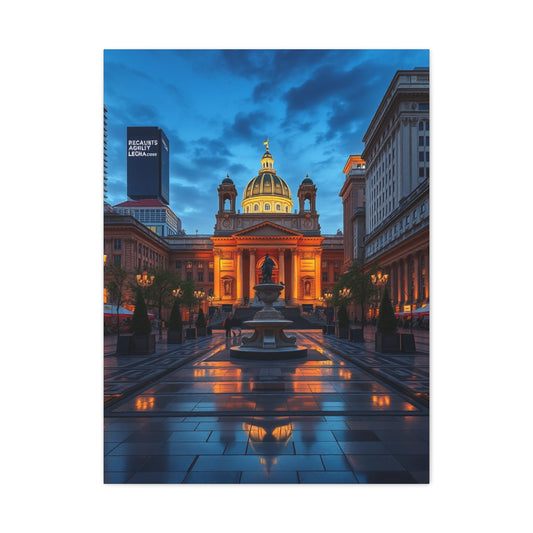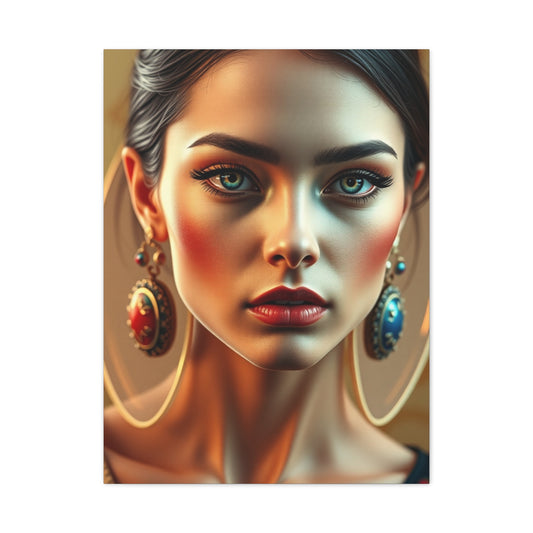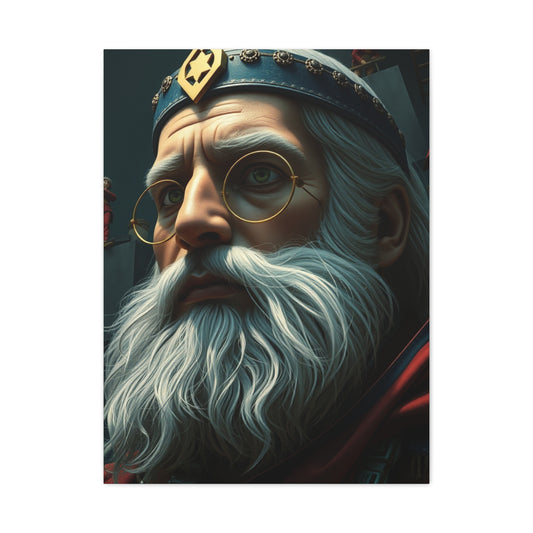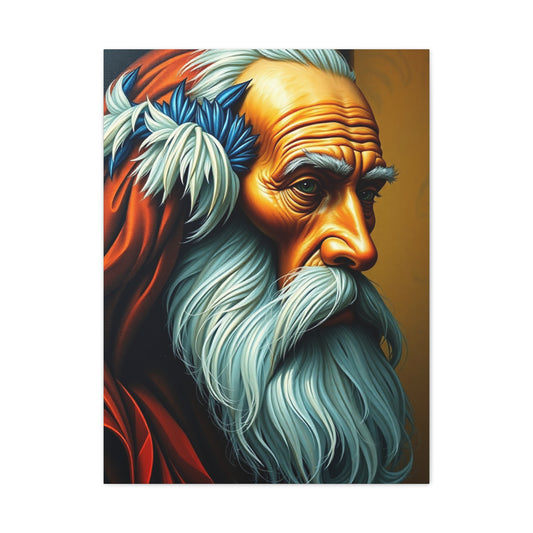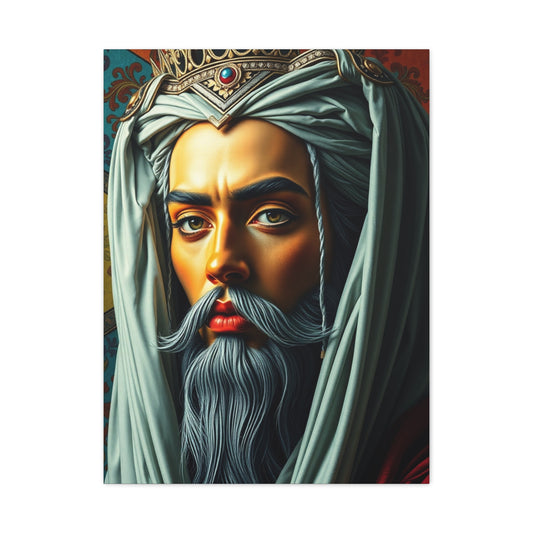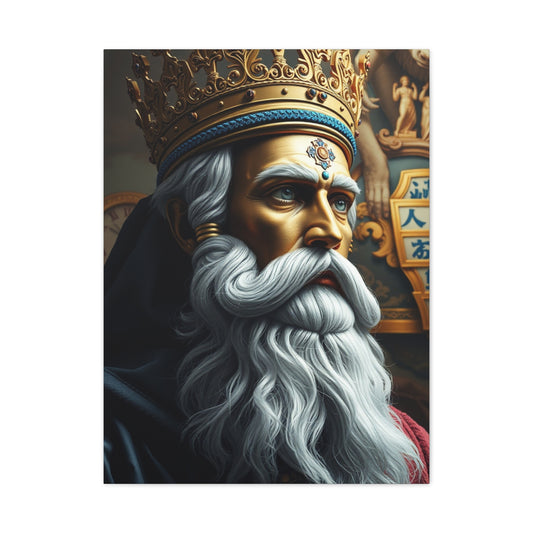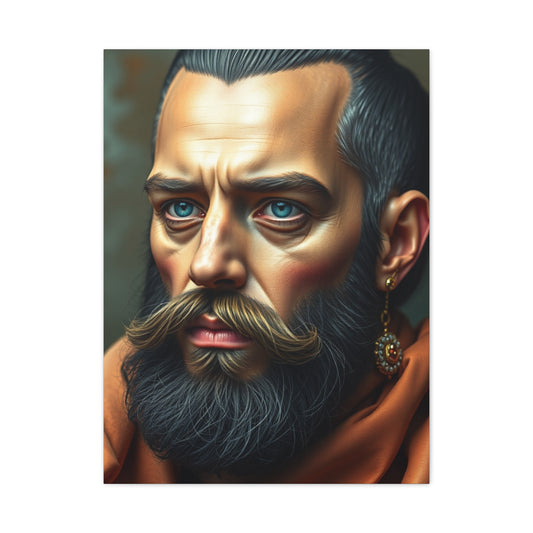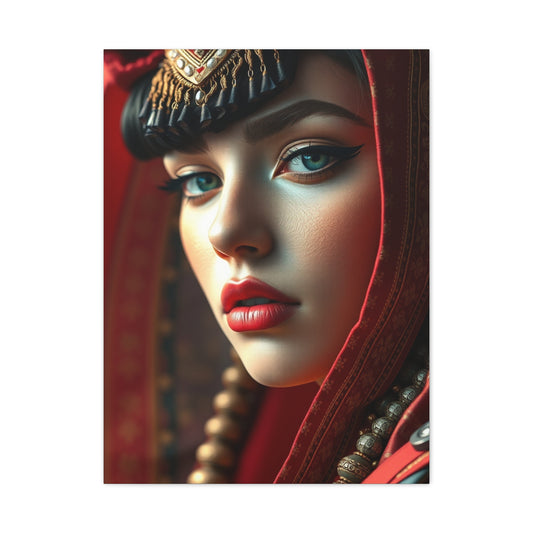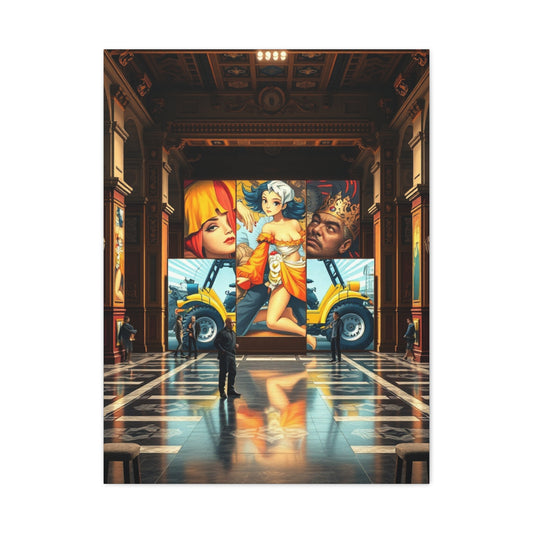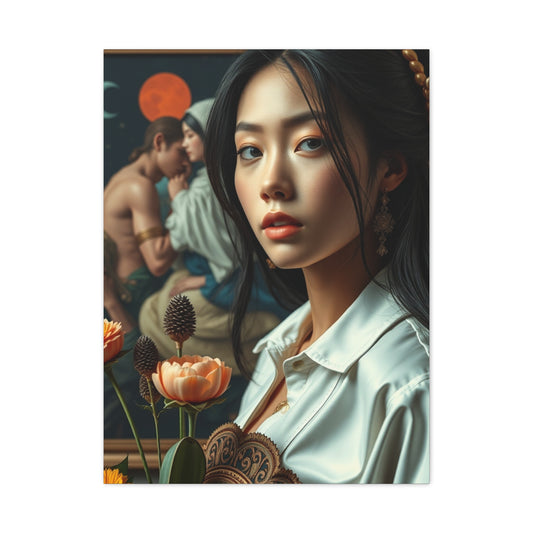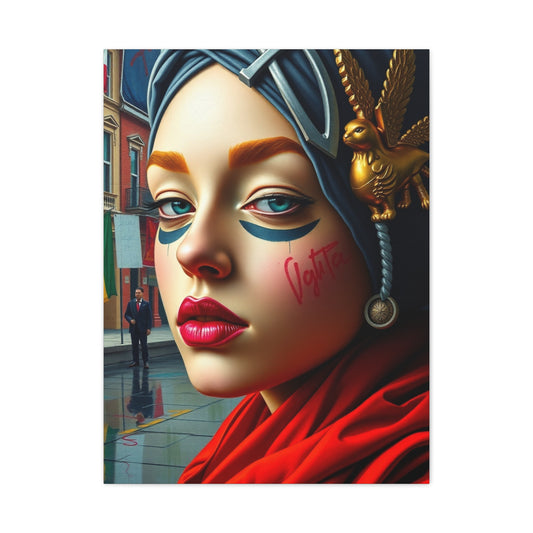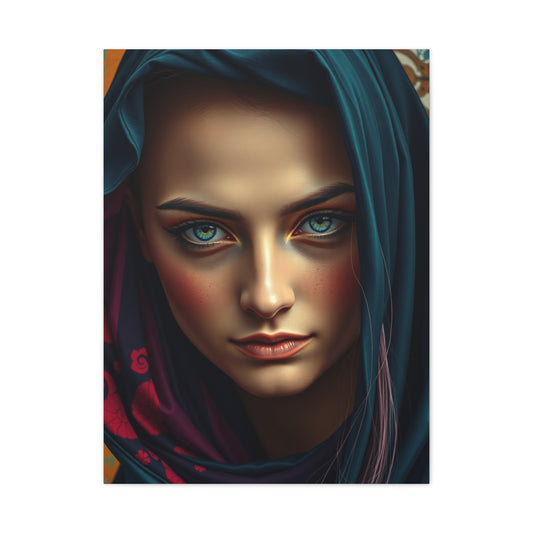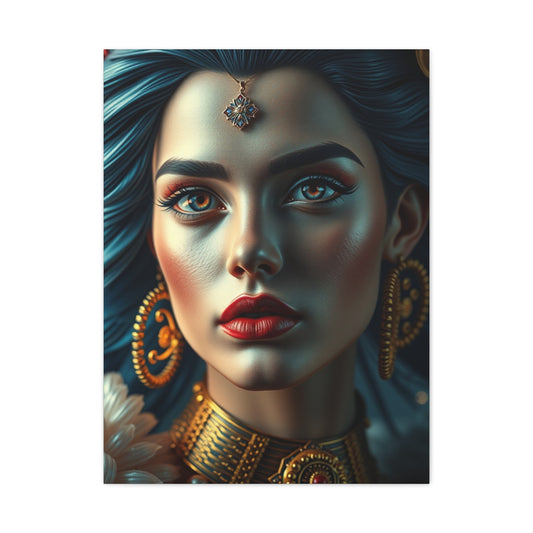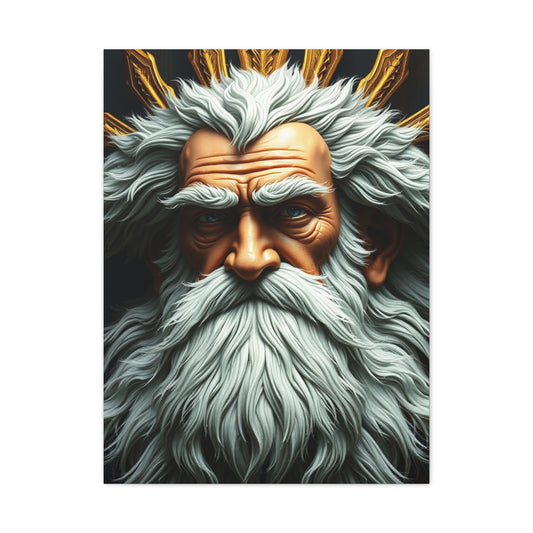Transforming Spaces with Maximalist Wall Art
In a world where minimalism often takes the spotlight with its emphasis on restraint, harmony, and bare elegance, maximalist wall art has emerged as a spirited counterpart. This style thrives on visual complexity, rich palettes, and immersive layering, turning walls into vibrant expressions of identity and creativity. Rather than adhering to the notion that less is more, maximalist wall decor leans on the philosophy that more can be meaningful when executed with intention. Every detail—from an ornate gilded frame to a bold mural—becomes part of a broader narrative, weaving together stories, cultures, and moods into a cohesive whole. For many, embracing this approach is not simply about ornamentation but about allowing personality to radiate through their surroundings.
Historical Background
Maximalist tendencies in design can be traced through centuries of artistic and cultural evolution, where the desire for visual abundance and layered expression has repeatedly resurfaced across different eras and geographies. In the grandeur of Baroque interiors, walls became immersive canvases, drenched in elaborate frescoes depicting mythological narratives and religious triumphs. Golden gilded embellishments sparkled under candlelight, while ornamental carvings and dramatic contrasts created an atmosphere of theatrical magnificence. These interiors were never merely decorative—they were statements of power, wealth, and cultural dominance.
As time moved forward, the Victorian era expanded the vocabulary of maximalism. Homes of this period embraced ornamentation as a mark of refinement, with walls adorned in patterned wallpapers, clusters of portraits, family heirlooms, and decorative objects collected from travels across the globe. The Victorian wall became a mosaic of identity, where each frame or ornament revealed something about the homeowner’s aspirations, status, or sentimental ties.
In Eastern traditions, walls often served as living scrolls of culture and spirituality. From the intricate mandalas in Indian temples to Chinese lattice patterns and Japanese screens painted with natural and symbolic motifs, wall surfaces functioned not only as design but as vessels of sacred storytelling. They carried wisdom, myths, and philosophies, embodying a harmony between artistic abundance and spiritual significance. Middle Eastern interiors, with their layered mosaics, arabesques, and calligraphy, also reflected this inclination toward opulence and detail, establishing walls as archives of cultural expression.
The twentieth century witnessed a reawakening of maximalist approaches through avant-garde and modernist experiments. Movements like Art Nouveau emphasized flowing organic forms and ornate detail, while Art Deco fused geometric opulence with luxurious materials. Later, Pop Art disrupted conventions entirely by filling walls with bold colors, celebrity portraits, comic imagery, and ironic juxtapositions, transforming ordinary interiors into provocative visual arenas. Maximalist wall art at this stage was no longer bound by historical reverence but became a rebellious force, delighting in spectacle and cultural commentary.
In contemporary times, maximalism has resurfaced as a counter-response to the sterile neutrality of minimalist trends that dominated the late twentieth and early twenty-first centuries. The minimalist pursuit of pared-down simplicity left many interiors feeling impersonal and muted, leading to a growing appetite for spaces that reflect individuality and narrative depth. Maximalist wall art answers this craving with unapologetic abundance, offering homeowners, designers, and collectors the freedom to embrace bold expression, personal storytelling, and layered beauty that resists conformity.
Core Concepts and Foundations
At its essence, maximalist wall decor is built upon three fundamental pillars: color, layering, and narrative. These components work together to transform blank walls into vibrant compositions that transcend mere ornamentation and instead become immersive experiences.
Color in maximalism is not restrained but unleashed. Walls may be saturated in deep jewel tones like emerald, sapphire, or amethyst, or splashed with energetic neon shades that pulsate with modern dynamism. Unlike minimalist palettes, which rely on muted hues and neutral backdrops, maximalist colors embrace daring contrasts and unexpected harmonies. Florals may coexist with stripes, neon yellows with velvet burgundies, or pastels with metallics, creating a kaleidoscopic richness that stimulates the senses and infuses the space with vitality.
Layering serves as the backbone of maximalist wall design. It is not limited to the physical act of hanging multiple artworks but extends to the orchestration of textures, forms, and dimensions. Paintings might overlap with woven wall hangings, sculptural mirrors, or vintage posters. Frames of varying styles and eras intermingle, while decorative accents—such as sconces, ceramic plates, or tapestry fragments—are woven into the arrangement. This interplay results in a curated abundance that feels organic rather than chaotic, allowing the wall to evolve like a living collection.
Narrative is perhaps the most compelling pillar, for maximalist walls are storytellers. Each element contributes a piece of a broader tale, whether it is a travel memory, a cultural homage, or a reflection of deeply personal passions. A wall might display heirloom photographs beside contemporary prints, symbolizing the dialogue between past and present. Another might juxtapose folk art with surrealist paintings, reflecting a homeowner’s eclectic curiosity. Unlike minimalist walls, which often serve as neutral voids to highlight emptiness, maximalist walls thrive on dynamism, echoing a sense of celebration, vibrancy, and life’s inexhaustible richness.
Together, these three foundations ensure that maximalist wall art never feels stagnant. Instead, it remains perpetually in flux, adapting as new pieces are added or reconfigured. The result is a layered tapestry that not only decorates but also communicates—an ever-changing narrative of abundance, emotion, and expression that elevates walls into vital participants in the lived environment.
Types and Categories
Maximalist wall decor manifests in many variations, each offering a unique mood and visual rhythm. Some lean toward eclectic bohemian, where tapestries, handwoven fabrics, and global artifacts converge into a mosaic of culture. Others embrace glamour and opulence, drawing on metallic finishes, crystal sconces, and oversized art pieces that mirror the extravagance of palatial interiors. A more contemporary take may incorporate digital art prints, geometric murals, and mixed media installations that blur boundaries between classic and modern aesthetics. Collectors often create gallery walls where oil paintings coexist with vintage posters, photographs, and curiosities. In every case, the walls cease to be background elements and instead become focal points of the living environment.
Practical Applications
When translating the principles of maximalism into actual spaces, balance remains vital even within abundance. Begin with a foundation—perhaps a richly patterned wallpaper or a bold painted accent wall—and allow additional layers to unfold gradually. Incorporating maximalist wall art means curating collections that speak to your sensibilities: from framed botanical illustrations to contemporary abstract canvases. Textural elements such as woven wall rugs, velvet panels, or metallic sculptures provide tactile intrigue. Furniture placement should enhance rather than compete with the walls, ensuring that the decor feels immersive rather than chaotic. Practical applications also extend to ceilings, corners, and alcoves, which can be adorned with murals, patterned moldings, or cascading greenery to extend the aesthetic beyond eye level.
Techniques and Methods
Crafting a maximalist wall is an art form that balances freedom with intention. One of the most important methods is layering, a process that involves arranging artworks, textures, and objects so that they build upon each other to create richness. Unlike minimalism, which prioritizes clear negative space, maximalism thrives when walls feel alive with overlapping dimensions. A gallery wall is a quintessential example, where paintings, photographs, and sketches are arranged in a way that feels spontaneous but maintains a rhythmic harmony.
Color blending is another method, but it requires a keen eye. Instead of limiting yourself to a subdued palette, maximalist wall art encourages experimentation with contrasts. Deep sapphire tones might be paired with golden hues, or vivid emerald could coexist with crimson and ochre. When these hues are tied together by patterns—such as wallpapers adorned with arabesque motifs or tapestries embroidered with floral explosions—the effect is immersive and captivating.
The incorporation of eclectic materials is also a signature technique. Mixing oil paintings with woven macrame, metallic wall sculptures, and printed textiles produces an interplay of surfaces that engages not just the eyes but also the imagination. The walls become a tactile storybook, inviting touch and interaction. Mirrors and reflective surfaces can be used to amplify this richness, capturing fragments of artworks and casting them across the room in unexpected ways.
Lighting plays an often underestimated role in maximalist wall decor. Strategic illumination transforms ordinary elements into theatrical statements. A spotlight directed at a gilded frame, or wall sconces that scatter light across a cluster of vintage posters, can redefine how the wall is perceived. Hanging plants, too, have become a subtle yet effective method, softening the heavy visual weight of framed art and creating an organic counterbalance.
One final method lies in narrative curation. Rather than randomly placing items on a wall, many maximalist designers treat the arrangement as a living archive of personal history. Framed postcards from travels, inherited heirlooms, and handmade crafts intermingle with high art, producing an authentic story that feels deeply human. In maximalism, technique is not about perfection but about orchestrating an abundance that feels intentional, layered, and celebratory.
Challenges and Common Mistakes
Despite its allure, maximalist wall art comes with challenges that require careful navigation. One of the most common mistakes is overindulgence without cohesion. When too many unrelated objects are crowded together, the result can feel chaotic rather than curated. While maximalism celebrates abundance, it is crucial to maintain an underlying thread—be it through color families, recurring motifs, or complementary textures—that unites the display.
Another pitfall lies in neglecting scale. A wall cluttered with dozens of small, unframed images can appear fragmented if not anchored by a larger focal piece. Conversely, filling the entire space with oversized artwork without variation may overwhelm rather than enchant. Successful maximalist decor strikes a balance between grandeur and detail, weaving large and small pieces together in a visually stimulating rhythm.
Lighting missteps also undermine the effect. Poorly lit walls can cause rich colors and intricate textures to appear flat or dull. Similarly, excessive use of harsh lighting may create glare that diminishes the warmth of the display. The challenge is to illuminate in ways that highlight depth without overpowering subtlety.
Texture overload is another risk. Combining too many fabrics, metallic finishes, and sculptural pieces without regard for proportion can result in a heavy and disjointed appearance. A curated selection of materials prevents the space from tipping into visual fatigue.
Perhaps the most underestimated mistake is ignoring the architectural bones of the space. Maximalist wall decor should interact with the room’s natural lines, windows, and ceilings. Covering every inch without respecting these elements can suffocate rather than inspire. True maximalism amplifies the character of the room rather than masking it.
Trends and Future Outlook
Maximalist wall art is undergoing a renaissance in contemporary design, propelled by a global shift toward personal expression and a rejection of sterile uniformity. One of the emerging trends is sustainability within maximalism. Rather than purchasing mass-produced art, many designers are incorporating upcycled, handmade, and locally crafted pieces. Vintage frames, second-hand textiles, and salvaged wood installations are gaining popularity, not only for their environmental benefits but also for their ability to infuse history into a space.
Another notable trend is the blending of technology with traditional decor. Digital wall art frames that can display rotating collections of classic paintings, animations, or personal photographs have become more common in maximalist homes. These tools allow for dynamic walls that evolve daily, embodying the ever-changing spirit of maximalism.
Global influence is also shaping the future. Patterns and artworks inspired by Moroccan tiles, Japanese woodblock prints, or South American weavings are increasingly layered into Western interiors, creating cross-cultural narratives. This trend reflects the modern desire for interconnectedness and cultural appreciation, where walls serve as cultural canvases.
In terms of aesthetics, bold murals are re-emerging as a maximalist favorite. From hand-painted botanical jungles to surreal dreamscapes that span entire walls, murals embody the daring essence of the style. Meanwhile, ceilings are becoming extensions of maximalist walls, painted with stars, floral bursts, or even geometric illusions, ensuring the decor extends beyond traditional boundaries.
Looking ahead, maximalist wall art is expected to become more adaptive, allowing homeowners to curate revolving displays. Modular shelving systems, magnetic frames, and interchangeable textiles are making it easier to refresh walls without starting from scratch. The future outlook suggests maximalism will continue to flourish as a counterbalance to minimalist trends, becoming an enduring expression of individuality in interior design.
Expert Insights
Designers who specialize in maximalist wall decor often emphasize the importance of intuition alongside planning. Many note that while rules of balance and scale are valuable, the essence of maximalism lies in trusting one’s instincts. If a wall feels inspiring and joyful, it has succeeded, regardless of whether it conforms to conventional guidelines.
Experts also point out that maximalist spaces benefit from layering stories, not just objects. A wall adorned with personal photographs, childhood drawings, and travel mementos carries far more resonance than a purely aesthetic arrangement. This storytelling aspect elevates maximalist wall art from decoration to autobiography.
Another insight shared by seasoned designers is the role of editing. Even within maximalism, not every object needs to be displayed at once. Rotating collections can keep the wall fresh while preventing oversaturation. Experts often recommend seasonal adjustments, swapping heavy fabrics for lighter ones in warmer months or replacing certain artworks to reflect changing moods.
Many professionals also stress the value of experimentation. Unlike minimalist spaces, where a single mistake may be glaring, maximalist walls offer more room for trial and play. A misplaced painting or mismatched frame can sometimes enhance rather than detract, lending the wall a sense of spontaneity. This tolerance for imperfection makes maximalism approachable and forgiving, even for those new to design.
Finally, experts remind us that maximalism should never be about imitation but about authenticity. Borrowing inspiration from design magazines or curated exhibitions is natural, but the most powerful maximalist walls are those that reflect genuine passions and lived experiences. Whether through bold tapestries, eclectic gallery walls, or ornate sculptures, maximalist wall art becomes a mirror of the soul when curated with sincerity.
Emerging Trends in Wall Art
The world of wall art is constantly evolving, shaped by cultural shifts, technological progress, and the yearning for self-expression. While maximalist wall decor has always been associated with extravagance and boldness, the contemporary landscape is reimagining this ethos through new mediums, sustainable practices, and global influences. What emerges is a dynamic mix of innovation and tradition, where walls become living canvases reflecting not only personal taste but also the zeitgeist of our times.
One of the most compelling trends is the rise of eco-conscious design. Increasingly, designers and homeowners are embracing recycled materials, reclaimed wood installations, and artworks crafted from sustainable textiles. This approach not only reduces environmental impact but also lends authenticity and depth to the space. Wall art created from natural dyes, organic fabrics, and locally sourced pigments carries a sense of timelessness while contributing to ecological responsibility.
Another emerging trend is the integration of interactive digital art. With advances in display technology, walls are no longer static surfaces. Digital frames and projection systems allow for rotating exhibitions, animated visuals, and immersive storytelling. Imagine a wall that transitions from a vibrant abstract painting during the day to a soothing landscape at night, offering a dynamic atmosphere that adapts to mood and occasion. For maximalist wall art, this fusion of digital fluidity with traditional abundance creates an entirely new dimension.
Globalism continues to inspire wall decor trends, with a noticeable shift toward multicultural layering. Tapestries inspired by South American weaving traditions, hand-painted Indian murals, African masks, and Japanese calligraphy scrolls are increasingly incorporated into Western interiors. This cross-pollination of aesthetics reflects the interconnectedness of cultures and satisfies the human desire for exploration. In maximalist contexts, these diverse influences blend harmoniously, producing spaces that feel like curated museums of the world.
Personalization is another key trend. Bespoke wall art, such as custom portraits, hand-lettered quotes, or commissioned pieces from local artists, has gained momentum as individuals seek to infuse their interiors with meaning beyond decoration. Unlike mass-produced prints, these personalized artworks tell unique stories and transform walls into deeply intimate reflections of their owners.
The use of oversized installations is also becoming more prevalent. Rather than relying solely on multiple smaller artworks, many designers are opting for expansive wall sculptures, panoramic murals, or large mixed-media pieces that command attention. These monumental works serve as anchors within maximalist schemes, providing balance to the abundance of surrounding elements.
Finally, the rediscovery of artisanal craftsmanship is shaping the future of wall decor. Hand-painted tiles, carved wooden panels, and intricately embroidered textiles are increasingly valued over machine-made reproductions. This shift toward craftsmanship aligns with the maximalist principle of cherishing uniqueness and celebrating human creativity.
Step-by-Step Guides
Achieving maximalist wall art may appear daunting at first glance, but with careful planning and creative courage, anyone can transform their space into a captivating sanctuary of abundance. Below is a step-by-step approach to guide you through the process of embracing this bold aesthetic.
Step 1: Define Your Narrative
Before placing a single piece on your wall, reflect on the story you wish to tell. Maximalist wall decor is not about random accumulation but about weaving together elements that represent your identity. Do you want your walls to convey wanderlust through travel mementos, or perhaps to showcase artistic passion through eclectic canvases and sketches? Clarifying your narrative provides direction and prevents your decor from descending into disarray.
Step 2: Establish a Foundation
Every maximalist wall needs a foundation that anchors the rest of the design. This could be a bold wallpaper with dramatic florals, a deep-toned paint color, or even a large mural that sets the tone. The foundation acts as the backdrop, framing the layers of art and objects that will follow. Choosing a strong base ensures cohesion, even when a multitude of elements are later added.
Step 3: Curate Your Collection
Select artworks and decorative pieces that align with your chosen narrative. Mix various styles, such as contemporary prints with antique portraits or handcrafted tapestries alongside modern photography. Variety is essential, but seek connections—whether through shared colors, themes, or materials—that tie the pieces together. Remember that maximalist wall art thrives on abundance, yet abundance without connection risks becoming overwhelming.
Step 4: Play with Scale and Proportion
Balance is crucial, even in maximalism. Combine large statement artworks with smaller supporting pieces. For example, a towering mirror or oversized painting might serve as the centerpiece, while surrounding it with clusters of smaller frames adds rhythm and movement. Play with vertical and horizontal arrangements to ensure the wall feels dynamic and layered rather than flat.
Step 5: Layer Textures and Fabrics
Introduce tactile richness by incorporating fabrics, carvings, or sculptural objects. A velvet wall hanging, an embroidered fabric panel, or a three-dimensional wooden relief adds sensory depth. These textured elements soften the impact of hard frames and bring warmth to the space. In maximalist design, texture is as important as color, providing a tangible dimension to visual complexity.
Step 6: Incorporate Functional Elements
Maximalist wall decor extends beyond pure ornamentation. Consider integrating functional objects such as ornate shelves, decorative lighting fixtures, or hanging planters. These elements blur the line between utility and art, allowing your walls to serve multiple purposes while maintaining aesthetic richness. A shelf lined with eclectic curiosities or sconces with intricate detailing can become as expressive as paintings.
Step 7: Experiment with Arrangement
Once you have assembled your collection, experiment with different placements before committing. Lay artworks on the floor to test combinations, or use removable adhesive strips to temporarily try arrangements on the wall. Maximalism encourages creativity and spontaneity, so do not be afraid to take risks. Sometimes unexpected juxtapositions create the most striking results.
Step 8: Pay Attention to Lighting
Illumination is the secret weapon of maximalist wall art. A well-placed spotlight can transform an ordinary painting into a dramatic focal point, while soft ambient lighting can enhance the richness of layered textures. Consider mixing different light sources—such as overhead chandeliers, wall sconces, and table lamps—to create depth and atmosphere. Lighting not only highlights the art but also influences the overall mood of the room.
Step 9: Extend Beyond the Wall
Maximalism does not stop at the edges of the wall. Extend your decor upward to the ceiling or outward into the room. Painted ceilings, hanging plants, or even floor-to-wall installations can expand the sense of immersion. The goal is to create an environment where the walls interact with the entire space, producing a unified and enveloping atmosphere.
Step 10: Refine and Refresh
Maximalist wall decor is not static; it evolves. Periodically revisit your arrangement, swapping pieces, adding new finds, or rotating collections to maintain freshness. This adaptability ensures that your walls remain vibrant and reflective of your evolving tastes and experiences. Maximalism thrives on growth, so embrace the opportunity to continually refine and reinvent.
Maximalism Beyond Domestic Walls
The influence of maximalist wall art is not confined to private interiors. Public spaces increasingly adopt its philosophy to create atmospheres that linger in memory. Museums curate immersive exhibitions where entire walls are enveloped in layered installations rather than singular artworks. Boutique hotels, especially those designed for experiential travelers, often employ maximalist walls to foster wonder and narrative continuity across their halls and guest suites. Restaurants seeking to stand out in competitive cities embrace maximalist murals, vintage posters, or eclectic gallery-style arrangements, transforming dining into an event rather than a necessity.
Corporate spaces, too, are beginning to explore maximalism as a strategy for differentiation. Offices that once embraced sterile minimalism now integrate bold wall installations to inspire creativity among employees. A conference room wall filled with diverse artworks can spark conversation, encourage unconventional thinking, and convey a company’s willingness to celebrate individuality. In educational institutions, maximalist walls filled with student art, cultural motifs, and inspirational imagery nurture an environment of imagination and inclusivity.
Cross-Generational Perspectives
Maximalist wall decor resonates differently across generations. For older generations, it may evoke nostalgia, echoing the abundance of mid-century homes or the opulent styles of their youth. For younger audiences, maximalist walls often represent freedom from uniformity, a chance to resist the impersonal trends of mass-produced decor. The digital-native generation, accustomed to visual saturation online, often finds comfort in bringing that abundance into physical space, translating digital eclecticism into tactile interiors.
Interestingly, generational dialogue is visible within maximalist walls themselves. An heirloom clock passed down from grandparents may be surrounded by digital art displays curated by younger homeowners. A collection of vinyl records can coexist with neon signage, symbolizing the blending of temporalities within one expressive surface. This multigenerational layering makes walls not just backdrops but archives of lineage, memory, and cultural dialogue.
Symbolic Power of Abundance
Walls filled with art and ornament carry symbolic weight beyond beauty. In many cultures, abundance has historically symbolized prosperity, fertility, and protection. A maximalist wall overflowing with color and pattern echoes these ancient associations, suggesting vitality and resilience. For some, layering artworks provides psychological assurance—a reminder of fullness in a world that often feels fragmented.
There is also a philosophical resonance to maximalism. Where minimalist walls reflect ideals of emptiness and serenity, maximalist walls embody the embrace of complexity, imperfection, and the multifaceted nature of human existence. Each layer symbolizes another aspect of life—contradictions, passions, memories—all coexisting in harmony. To dwell within such spaces is to accept that beauty is rarely simple, that meaning is often born from juxtaposition and excess.
Inspirations from the Natural World
Though maximalism is often associated with human-made abundance, many of its principles are found in nature. Forests are maximalist by essence, layered with textures, colors, sounds, and rhythms. Coral reefs, too, embody maximalist design with their dazzling arrays of forms and hues. Translating this natural maximalism into wall decor can involve botanical murals, floral wallpapers, or clusters of organic sculptures resembling vines or shells. By mirroring the richness of natural ecosystems, maximalist walls reconnect interiors with the vitality of the earth.
The Role of Storytelling in Maximalist Walls
One cannot overstate the storytelling capacity of maximalist wall art. Unlike minimalist walls, which often recede into silence, maximalist walls speak—sometimes loudly, sometimes softly, but always with presence. They narrate histories, display journeys, and embody the collector’s eye. A gallery wall combining tribal masks, surrealist prints, and vintage travel posters may tell of curiosity and exploration. A wall lined with children’s artwork, photographs, and handmade crafts might narrate a family’s evolution over decades.
Storytelling also appears in thematic maximalist walls. Some homeowners dedicate walls to music, covering them with album art, concert posters, and instrument fragments. Others build walls devoted to literature, where book covers, framed manuscripts, and typographic art coexist. These thematic walls reflect obsessions and passions, transforming interior decor into biography.
Community and Collective Maximalism
An intriguing extension of maximalist wall art is its role in community expression. Murals created by local artists often turn blank urban walls into maximalist spectacles, filled with layers of color and symbolism that resonate collectively. These public maximalist expressions transform cityscapes into shared canvases, reflecting cultural identity and social narratives. Within neighborhoods, community centers and cultural hubs adopt maximalist walls as collaborative projects where residents contribute their own pieces, creating walls that represent collective spirit rather than individual taste.
Advanced Techniques in Expression
Once the foundations of maximalist wall decor have been mastered, the journey moves toward more intricate forms of expression. Advanced techniques often focus on curating a dialogue between disparate elements. Instead of merely layering paintings or fabrics, the aim becomes orchestrating conversations between them. A Renaissance-inspired portrait might be deliberately placed beside a contemporary abstract canvas, creating tension and harmony simultaneously. This juxtaposition awakens curiosity, compelling the viewer to question, compare, and connect.
Another advanced technique involves the manipulation of architectural features. Alcoves, stairwell walls, or unexpected recesses can be transformed into immersive art zones. Rather than confining decor to flat walls, maximalist practitioners explore depth by embedding sculptural elements, inset shelving, or carved panels that merge with the architecture itself. This symbiotic relationship between structure and embellishment elevates the wall into a living artwork rather than a backdrop.
Integration of sensory elements is also gaining recognition. Walls infused with aromatic woods, textured plaster, or even sound-responsive installations create multi-sensory experiences. The maximalist ethos thrives in such environments, where every sense is stimulated and every encounter feels immersive. This transforms interiors into theaters of expression, where sight, touch, and sound collaborate to produce atmosphere.
Cultural Dimensions and Symbolism
Maximalist wall art often reaches beyond aesthetics to embrace symbolism and cultural meaning. Walls adorned with sacred motifs, ancestral heirlooms, or mythological imagery become repositories of identity. In many traditions, walls are canvases for heritage—be it Chinese calligraphy scrolls that embody wisdom, Mexican Talavera tiles that echo history, or African beadwork that celebrates ritual. By blending these traditions into a maximalist framework, designers craft spaces that are not just visually striking but culturally resonant.
Symbolism can also manifest through personal mythologies. Some individuals create maximalist walls that narrate their life journeys, layering childhood sketches with university posters, travel souvenirs, and professional accolades. These walls act as visual autobiographies, capturing the fullness of existence and embedding meaning in everyday living.
Psychological Impact of Maximalist Walls
Maximalist wall decor influences the psyche in profound ways. Unlike minimalist spaces, which aim to quiet the mind, maximalist walls stimulate thought, imagination, and memory. They invite exploration, offering endless details for the eye to discover. Psychologists suggest that such environments nurture creativity, as the abundance of stimuli encourages divergent thinking.
For some, these walls evoke comfort. Surrounded by familiar objects, cherished collections, and vibrant patterns, individuals often feel cocooned in an atmosphere that reflects their identity. The sheer richness provides a sense of belonging, transforming the home into an extension of the self. However, when poorly executed, maximalist walls may overwhelm, producing restlessness rather than comfort. This underscores the importance of intentionality in their creation.
Practical Applications in Modern Interiors
In modern living spaces where open floor plans dominate, maximalist wall art serves as a powerful tool for delineation. A boldly adorned wall can define the dining area within a large multipurpose room, creating intimacy and visual identity. Similarly, in work-from-home environments, maximalist backdrops behind desks can energize creativity while serving as expressive backgrounds for digital interactions.
Hospitality and retail spaces also harness the allure of maximalist walls. Restaurants often use layered murals and eclectic artwork to create memorable dining experiences. Boutiques deploy walls adorned with ornate mirrors, fabrics, and art installations to entice customers with atmospheres that feel immersive and distinct. These practical applications demonstrate that maximalist wall art transcends domestic interiors, influencing commercial and communal spaces with equal force.
Integration with Other Design Styles
One of the fascinating aspects of maximalist wall decor is its adaptability. It can coexist with other design philosophies, producing hybrid aesthetics. A Scandinavian-inspired home, for instance, may embrace clean-lined furniture but offset it with a single maximalist gallery wall that injects energy into the space. Similarly, industrial lofts often incorporate maximalist walls filled with vintage posters, graffiti-inspired murals, and textured raw finishes, achieving a balance between ruggedness and richness.
The bohemian aesthetic is a natural partner for maximalist walls, with woven fabrics, tribal masks, and layered colors blending seamlessly. Meanwhile, classical styles find synergy through ornate frames, historical paintings, and decorative moldings that amplify grandeur. This ability to merge with other styles ensures maximalist walls remain versatile and relevant across diverse design languages.
Challenges in Long-Term Maintenance
While maximalist walls captivate, they also pose long-term challenges. Dust accumulation on layered fabrics, difficulty in repositioning large murals, and the risk of fading colors under sunlight are common concerns. Proper maintenance becomes essential, involving regular cleaning, careful preservation of delicate materials, and periodic reassessment of placement.
Another challenge lies in evolving tastes. What feels harmonious today may feel overwhelming tomorrow. The solution lies in flexibility—choosing modular display systems, rotatable artwork, or easily replaceable wallpapers that allow adaptation without dismantling the entire composition. By planning for change, homeowners can ensure their maximalist walls remain inspiring over time.
The Future of Maximalist Wall Art
Looking forward, maximalist wall decor is set to expand its influence through technological innovation and cultural fluidity. Augmented reality is already being used by designers to preview arrangements, allowing clients to experiment with bold configurations before committing. Walls may soon become interactive surfaces that change visuals with a simple command, offering endless possibilities for reinvention.
Cultural fusion will continue to enrich the style. As globalization deepens, motifs from diverse traditions will find new expressions within maximalist walls, blurring boundaries between continents and eras. Sustainability will also play a central role, with future maximalist walls emphasizing handmade, ethical, and eco-friendly artistry. The emphasis will not just be on beauty but also on responsibility, ensuring that abundance does not come at the cost of the planet.
Expert Recommendations for Enthusiasts
Design professionals often advise beginners to start gradually. Instead of overwhelming every wall, focus on one area as an experimental canvas. Build layers over time, trusting intuition to guide the process. Experts stress that maximalist walls should not mimic staged showrooms but emerge organically, shaped by the objects that hold meaning for the owner.
Another recommendation is to blend permanence with flexibility. Large murals or bold wallpapers may serve as anchors, while smaller framed artworks and fabrics can rotate seasonally. This ensures freshness while maintaining stability. Professionals also highlight the importance of lighting design, encouraging the use of layered illumination to dramatize textures and emphasize focal points.
Above all, experts underscore authenticity. The most successful maximalist walls are not those that follow trends slavishly but those that radiate individuality. Whether adorned with travel artifacts, vintage heirlooms, or bold contemporary art, walls that echo genuine passion achieve timeless allure.
Conclusion
Maximalist wall decor is more than a fleeting trend; it is a philosophy of living expressed visually. It thrives because it resonates with something fundamental in human nature: the desire to surround oneself with meaning, memory, and beauty. Walls transformed through maximalism are not silent surfaces but vibrant storytellers, reflecting who we are and how we live.
By embracing advanced techniques, respecting cultural symbolism, and integrating sustainable practices, maximalist walls will continue to evolve while remaining rooted in abundance. They hold power not only to decorate but to inspire, to comfort, to provoke thought, and to connect people across time and culture.
The beauty of maximalist wall art lies in its refusal to reduce life to a single note. Instead, it composes symphonies of color, pattern, and narrative. Standing before such a wall is like entering a world of endless discovery, where each glance reveals a new detail, a hidden story, or an unexpected harmony. These walls remind us that complexity can be beautiful, that excess can be intentional, and that our environments can be as expressive and multifaceted as we are.
For those who choose this path, maximalism offers a rare gift: a living canvas that grows alongside its curator, evolving with each new addition, memory, or dream. In its fearless embrace of abundance, maximalist wall art whispers an invitation—not to restrain—but to reveal, not to erase—but to celebrate, not to simplify—but to honor the fullness of life itself.

